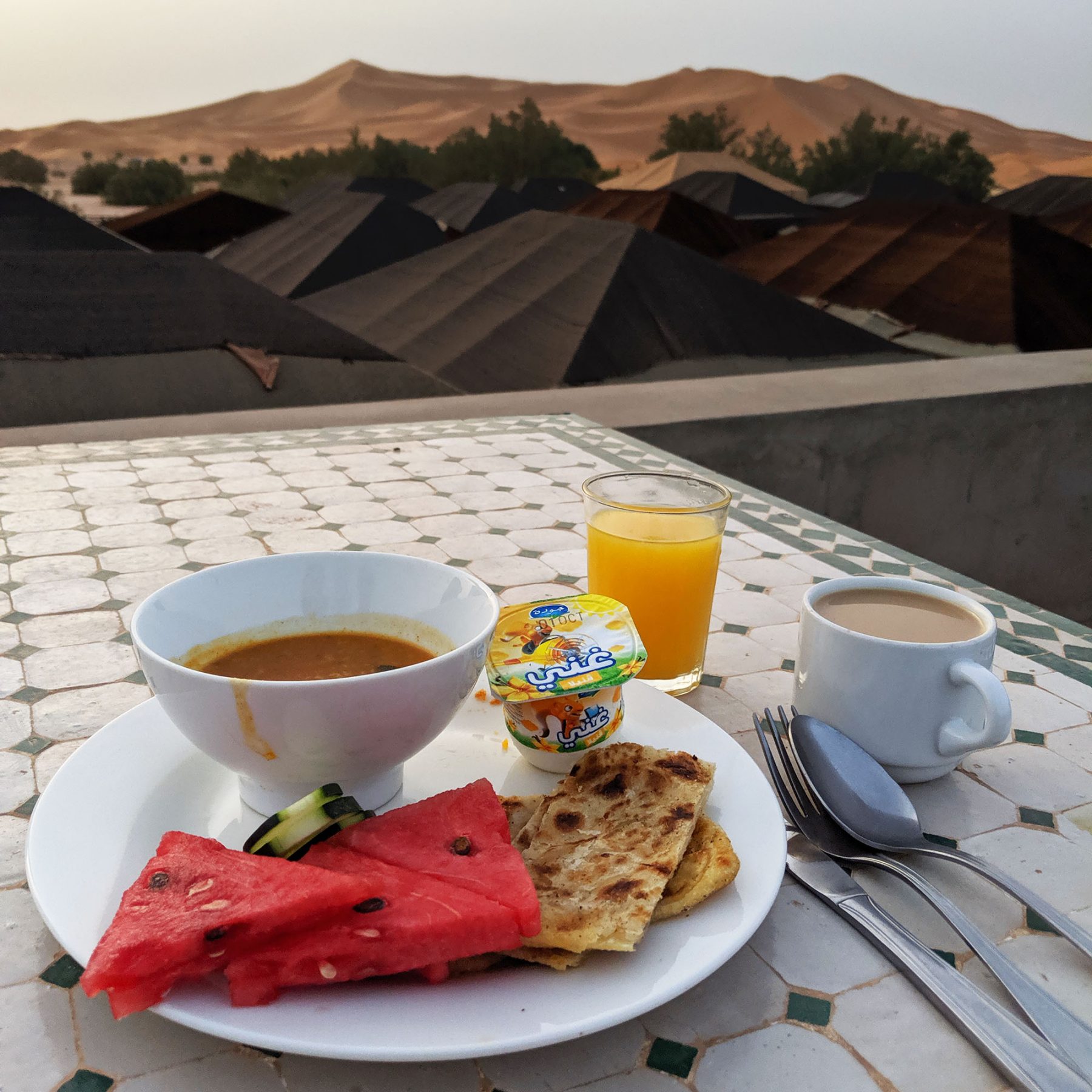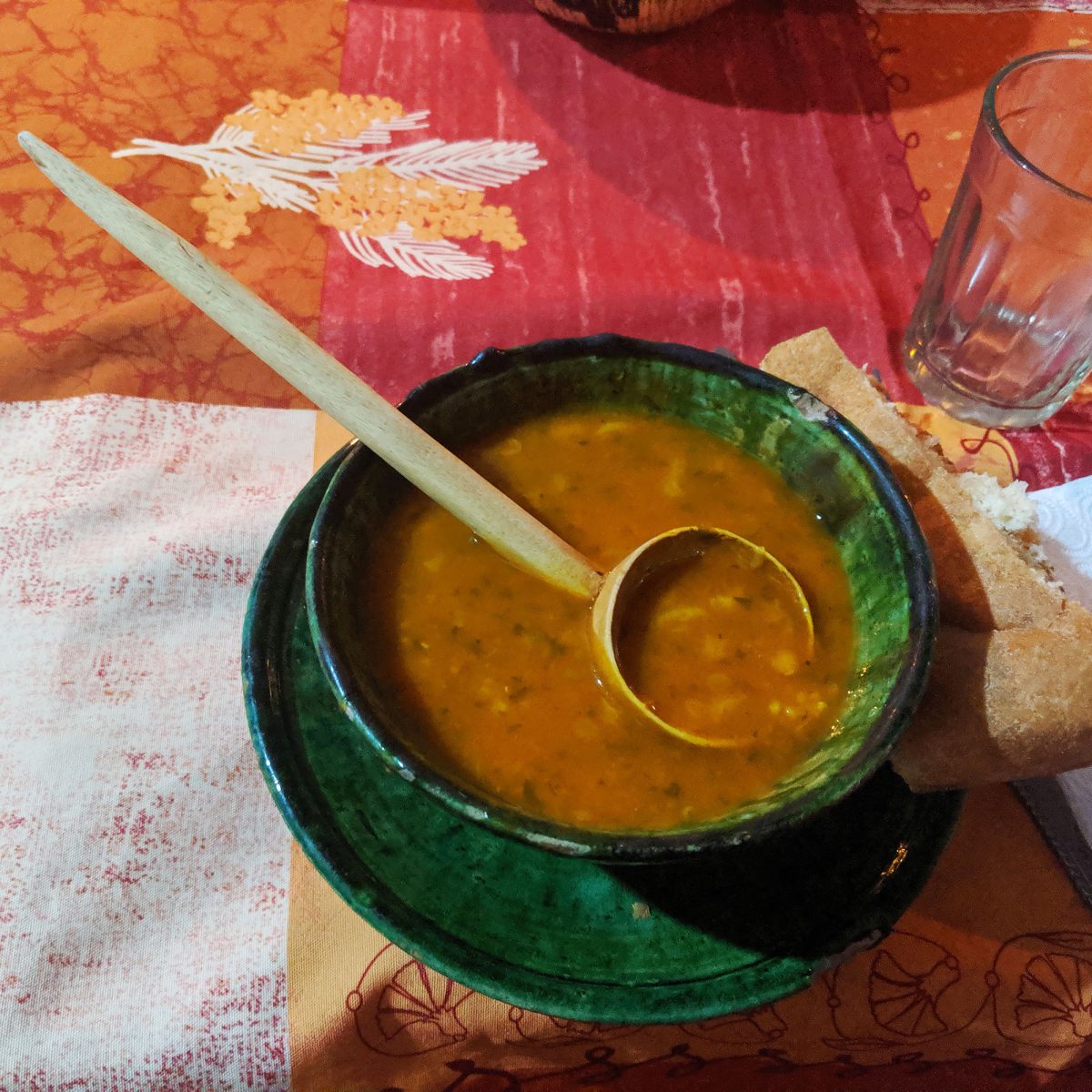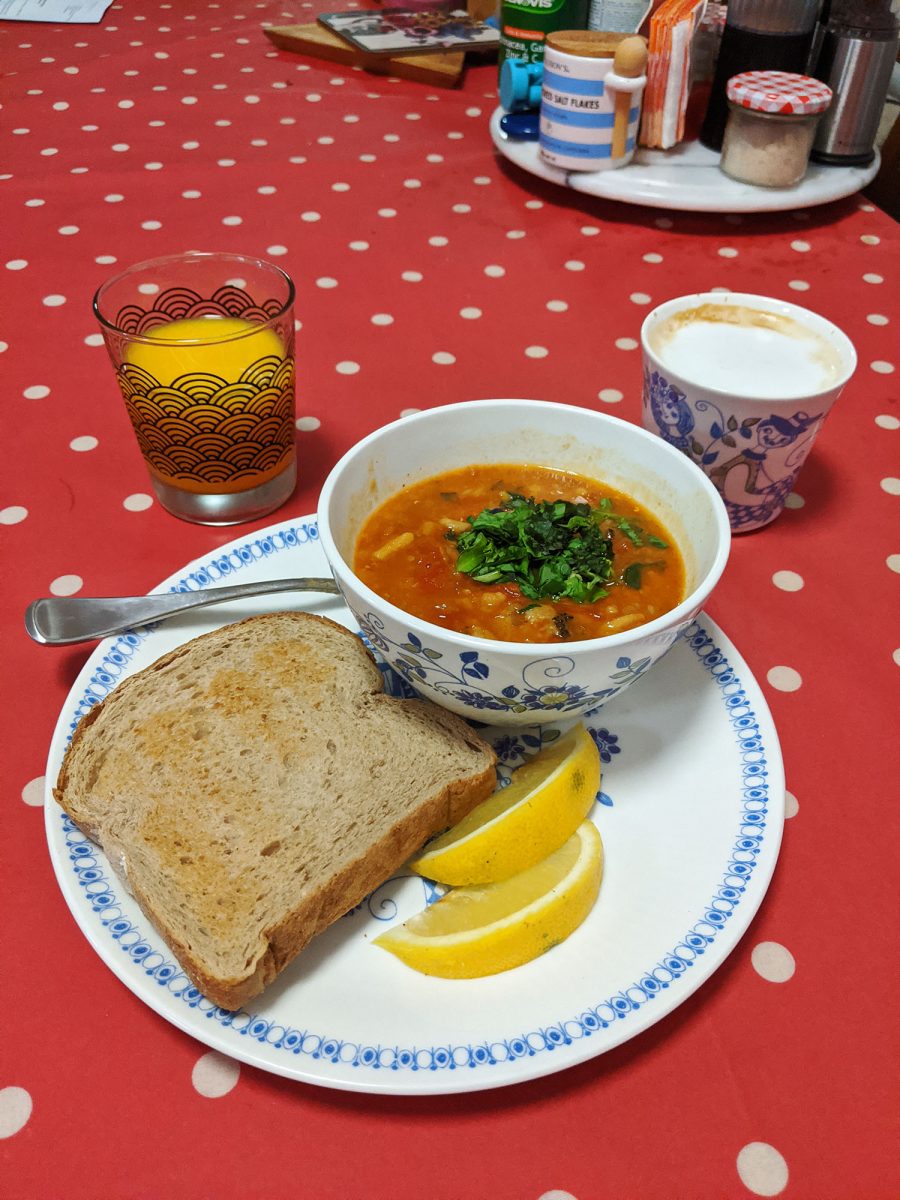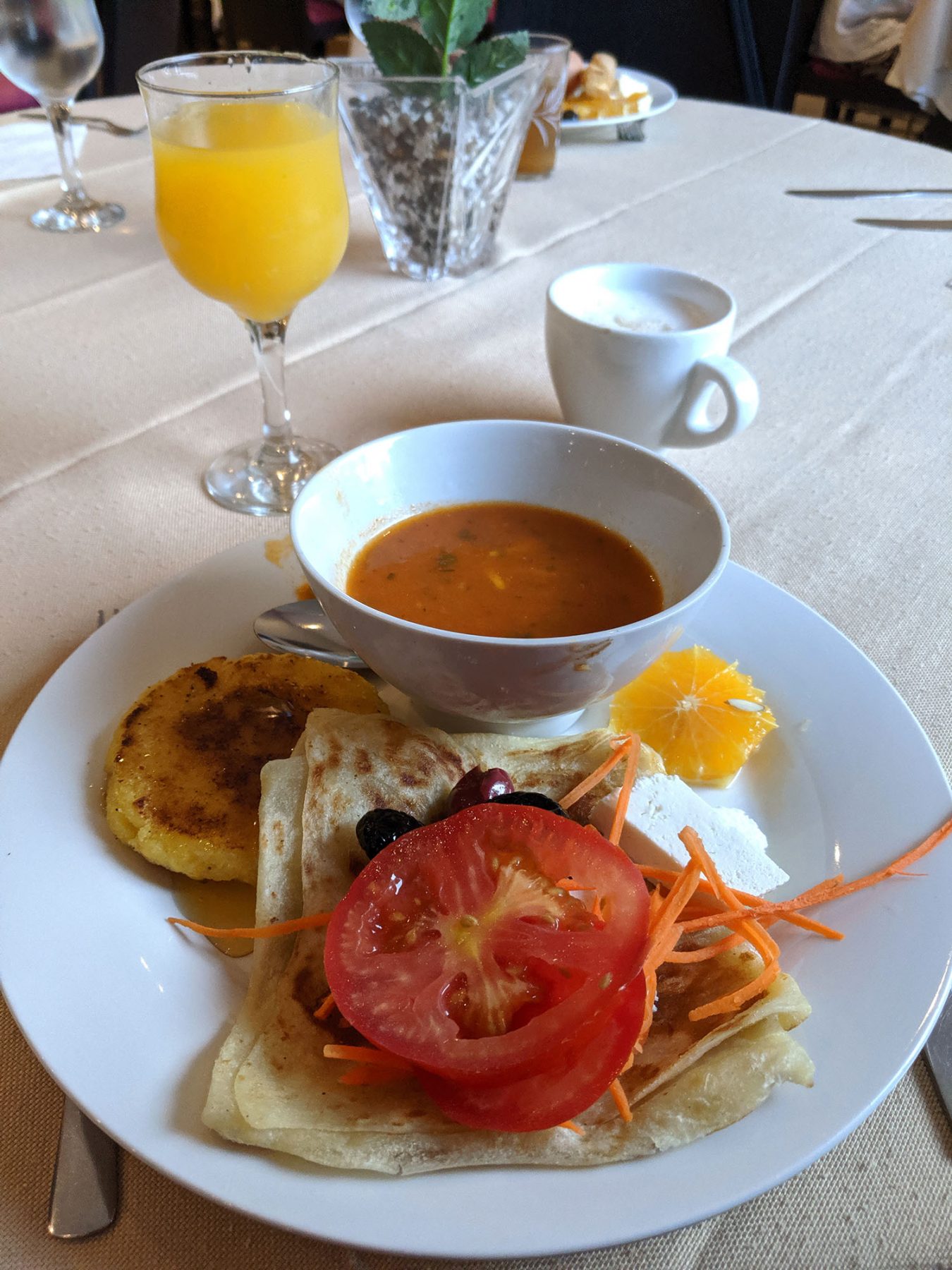One of my fondest food discoveries from Morocco was the Harira soup. Savouring the different versions we had of it as we travelled around that great country was a total delight.
Some times, it had vermicelli in, some times not.
Some times, it was made on a meat stock base, some times not.
Some times, it was quite a thin soup, some times not.
Some times, it had quite a few lentil varieties in it, some times not.
Some times, it was quite red, sometimes it was more orange.
Every time it was pretty darn tasty, some times just a lot more tasty 🙂
It was one of the foods that every time we were presented with a buffet, I quickly scoped out the soup option, would this soup that I so dearly loved be present?
When a pot of soup would be brought to our table by our cooks or hosts whilst travelling, I eagerly awaited the opening of the pot, would it contain this soup that I so dearly loved?
Since I returned home, mastering this soup has been on my list of things to do. I’ve read countless, countless recipes online in English and French using my average French language skills that extend to well recipes 😀
Looking at pictures, to see if I could find a recipe that resembled most the versions of Harira that I liked the most.
As the days start to sometimes get a little cooler here in Brisbane, it seemed fitting to finally make Harira as the first soup of the season. The Islamic world has just started Ramadan and Harira is a very common fast breaking soup in Morocco so it seemed like a fitting soup to make to reflect on.
In the end, I turned to the Moroccan recipe book that has been a trusty companion for many, many years now; Arabesque by Claudia Roden. A book that actually is recipes from Morocco, Turkey and Lebanon but well, in the 14 years of owning this recipe book, I’ve not strayed much out of the Moroccan section 😀
In all the years of having this book, I’ve never made any of the soups out of the book, well that has now changed 🙂 Last night, after a long day at work, I made Harira.
Though in both true #isolife style and Helen’s make do in whilst cooking approach, my soup did not turn out anything like I imagine Claudia Roden’s did 😀
My soup was started on the stove and finished in the slow cooker overnight.
My soup, had red lentils instead of brown lentils.
My soup had carrots instead of celery.
My soup had lamb soup pieces on the bone instead of 1cm cubed pieces of meat.
My soup was made with 3 tins of tomatoes instead of fresh tomatoes.
My soup didn’t have any tomato paste in it because I had run out and due to COVID-19 ISO life, I was not about to run down to the shops to just get tomato paste, celery and brown lentils 😀
My soup used powdered cinnamon because well cinnamon sticks?
My soup had paprika in the spice mix as well because it seemed common in the many, many recipes I had reviewed.
My soup used a small handful of spaghetti broken into short pieces to substitute the vermicelli.
My soup had shredded spinach and kale in it instead of coriander and parsley.
My soup only used about a third of the flour/water mixture as any more would have thickened the soup way too much.
My soup was good but there will be a few more tweaks before I am 100% happy with the recipe.
My future tweaks will involve making a version with no meat base, a version with celery in it, playing with the spice mix as I didn’t quite get the mix right with this first go.
Claudia Roden’s recipe and backstory from Arabesque
CHICKPEA and LENTIL SOUP Harira
Harira is the generic term for a soup full of pulses – chickpeas, lentils or beans – with little meat, few vegetables and plenty of herbs and spices. Every day during the holy month of Ramadan, when Muslims fast between sunrise and sunset, the smell of this soup permeates the streets as every household prepares its own version to be eaten when the sound of the cannon signals the breaking of the fast.
While ingredients and spices vary, a particular feature is the way the soup is given what is described in Morocco as a ‘velvety’ touch by stirring in a sourdough batter or simply flour mixed with water. In the cities in Morocco, it serves as a one-dish evening meal, and in rural areas, it is also eaten as breakfast before peasants go out to work in the fields. During Ramadan, it is served with lemon quarters and accompanied by dates and honeyed pastries.
The soup can be made a long time in advance, but if you are adding the tiny birds tongue pasta -douida in Morocco (you find it in Middle Eastern stores), orzo in Italian stores (or you can use vermicelli) – these should be added only 10-15 minutes before you are ready to serve otherwise they will get bloated and mushy. I have given measurements for a large quantity because it is a rich, substantial soup that you might like to serve as a one-dish meal at a party. The best cuts of meat to use are shoulder or neck fillet.
SERVES 10
2 marrow bones, washed (optional)
500g lamb or beef
2 large onions, chopped coarsely
200g chickpeas, soaked overnight
150g large brown lentils, rinsed
500g ripe tomatoes, peeled and chopped
4 celery stalks, diced
1 tablespoon tomato paste
1 teaspoon black pepper
1 teaspoon ground ginger
2 cinnamon sticks
2 teaspoon saffron threads or powder or 1 teaspoon turmeric
salt
5 tablespoons plain flour
150g bird’s-tongue pasta or vermicelli (optional)
juice of 1 lemon
100g coriander, chopped
large bunch of flat-leaf parsley, chopped
To serve with: 3 lemons, cut into quarters: dates (optional)
If using marrow bones, blanch them in boiling water for a few minutes then throw out the water. Put the bones into a large pan with the meat, cut into 1cm pieces, the onions and drained chickpeas. Cover with about 3 litres water and bring to the boil.
Remove the scum and simmer, covered, for 1 hour. Remove the bones (if using), scoop out the soft marrow with a knife and drop it back into the soup.
Add the drained lentils, tomatoes and celery (include some leaves), the tomato paste, pepper, ginger, cinnamon and saffron or turmeric. Simmer for a further 15 minutes, adding more water if necessary as the level drops, and salt when the lentils begin to soften.
In the meantime, put the flour into a small pan and gradually add 500ml cold water, a little at a time, beating vigorously with a wooden spoon to blend well and to avoid lumps. Put over a medium heat and stir constantly until the mixture thickens, then simmer for 10 minutes. Pour this batter into the soup, stirring vigorously, and cook for a few minutes until the soup acquires a light creamy texture,
If you are using the tiny pasta or vermicelli (crush them with your hand into small pieces), add this to the soup 10 or so minutes from the end, adding the lemon juice, chopped coriander and parsley at the same time.
Serve with lemon wedges and if you like, also dates.
VARIATION Instead of meat, you can use 500g chicken fillets, preferably thighs, and crumble in 3 chicken stock cubes.




Looks good.